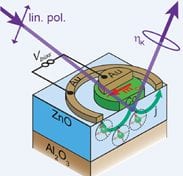Welcome to the latest selection of recent top articles in the physica status solidi journals. Get a glimpse of our publication spectrum and visit our pages by clicking on any of the DOI links below.
Zinc oxide films and nanomaterials for photovoltaic applications [Review@RRL]
Aleksandra B. Djurišić, Xiang Liu, and Yu Hang Leung
 In this article, an overview of possible applications of ZnO in solar cells is provided. The simplest possible applications of Zn-based materials in solar cells are transparent contacts and light trapping/light scattering structures. This technology, compared to applications of ZnO in dye-sensitized and other types of solar cells as electron transport layer, is reasonably mature. The authors briefly summarize the results achieved and the potential for further development. In addition, they discuss the use of ZnO as electron transport layer in polymer and nanostructured (not including dye-sensitized) solar cells. The results achieved and unresolved problems are described. Finally, the use of ZnO in dye-sensitized solar cells is discussed. An overall future outlook for photovoltaic applications is briefly summarized.
In this article, an overview of possible applications of ZnO in solar cells is provided. The simplest possible applications of Zn-based materials in solar cells are transparent contacts and light trapping/light scattering structures. This technology, compared to applications of ZnO in dye-sensitized and other types of solar cells as electron transport layer, is reasonably mature. The authors briefly summarize the results achieved and the potential for further development. In addition, they discuss the use of ZnO as electron transport layer in polymer and nanostructured (not including dye-sensitized) solar cells. The results achieved and unresolved problems are described. Finally, the use of ZnO in dye-sensitized solar cells is discussed. An overall future outlook for photovoltaic applications is briefly summarized.
Phys. Status Solidi RRL (2014) DOI 10.1002∕pssr.201300103
Magnetization states and magnetization processes in nanostructures: From a single layer to multilayers [Feature Article]
Andrzej Maziewski, Jürgen Fassbender, Jan Kisielewski, Marek Kisielewski, Zbigniew Kurant, Piotr Mazalski, Feliks Stobiecki, Andrzej Stupakiewicz, Iosif Sveklo, Maria Tekielak, Andrzej Wawro, and Vitalii Zablotskii
 Maziewski et al. present possibilities of engineering the magnetic properties (e.g. magnetic anisotropy and coercivity field) of nanostructures during deposition processes and post growth treatments, e.g. by ion irradiation and laser annealing. Magnetization distributions in single ultrathin layer and multilayers have been studied both experimentally (using Co films sandwiched between Au, Pt or Mo layers) and theoretically. Huge changes of these distributions, driven by the nanostructure geometry or the magnetic field, are shown.
Maziewski et al. present possibilities of engineering the magnetic properties (e.g. magnetic anisotropy and coercivity field) of nanostructures during deposition processes and post growth treatments, e.g. by ion irradiation and laser annealing. Magnetization distributions in single ultrathin layer and multilayers have been studied both experimentally (using Co films sandwiched between Au, Pt or Mo layers) and theoretically. Huge changes of these distributions, driven by the nanostructure geometry or the magnetic field, are shown.
Phys. Status Solidi A (2014) DOI 10.1002∕pssb.201300750
Zinc oxide – From dilute magnetic doping to spin transport [Feature Article]
M. Opel, S. T. B. Goennenwein, M. Althammer, K.-W. Nielsen, E.-M. Karrer-Müller, S. Bauer, K. Senn, C. Schwark, C. Weier, G. Güntherodt, B. Beschoten, and R. Gross
 The wide-bandgap semiconductor ZnO is a promising material with regard to dilute magnetic doping and spintronic applications. Opel et al. review the substitution with magnetic and non-magnetic ions, identify the formation of magnetic clusters, and demonstrate how extrinsic effects can obscure the magnetic measurements. The authors further demonstrate electrical spin injection into ZnO via optical and electrical detection schemes.
The wide-bandgap semiconductor ZnO is a promising material with regard to dilute magnetic doping and spintronic applications. Opel et al. review the substitution with magnetic and non-magnetic ions, identify the formation of magnetic clusters, and demonstrate how extrinsic effects can obscure the magnetic measurements. The authors further demonstrate electrical spin injection into ZnO via optical and electrical detection schemes.
Phys. Status Solidi B (2014) DOI 10.1002∕pssb.201350230

















